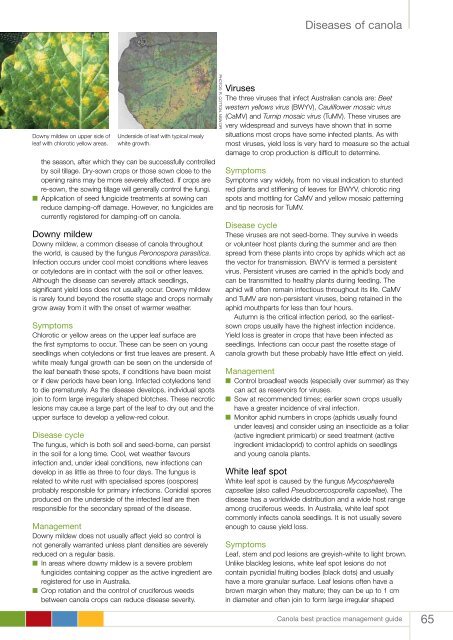best practice management guide for south-eastern Australia - Grains ...
best practice management guide for south-eastern Australia - Grains ...
best practice management guide for south-eastern Australia - Grains ...
Create successful ePaper yourself
Turn your PDF publications into a flip-book with our unique Google optimized e-Paper software.
Diseases of canola<br />
Downy mildew on upper side of<br />
leaf with chlorotic yellow areas.<br />
Underside of leaf with typical mealy<br />
white growth.<br />
the season, after which they can be successfully controlled<br />
by soil tillage. Dry-sown crops or those sown close to the<br />
opening rains may be more severely affected. If crops are<br />
re-sown, the sowing tillage will generally control the fungi.<br />
n Application of seed fungicide treatments at sowing can<br />
reduce damping-off damage. However, no fungicides are<br />
currently registered <strong>for</strong> damping-off on canola.<br />
Downy mildew<br />
Downy mildew, a common disease of canola throughout<br />
the world, is caused by the fungus Peronospora parasitica.<br />
Infection occurs under cool moist conditions where leaves<br />
or cotyledons are in contact with the soil or other leaves.<br />
Although the disease can severely attack seedlings,<br />
significant yield loss does not usually occur. Downy mildew<br />
is rarely found beyond the rosette stage and crops normally<br />
grow away from it with the onset of warmer weather.<br />
Symptoms<br />
Chlorotic or yellow areas on the upper leaf surface are<br />
the first symptoms to occur. These can be seen on young<br />
seedlings when cotyledons or first true leaves are present. A<br />
white mealy fungal growth can be seen on the underside of<br />
the leaf beneath these spots, if conditions have been moist<br />
or if dew periods have been long. Infected cotyledons tend<br />
to die prematurely. As the disease develops, individual spots<br />
join to <strong>for</strong>m large irregularly shaped blotches. These necrotic<br />
lesions may cause a large part of the leaf to dry out and the<br />
upper surface to develop a yellow-red colour.<br />
Disease cycle<br />
The fungus, which is both soil and seed-borne, can persist<br />
in the soil <strong>for</strong> a long time. Cool, wet weather favours<br />
infection and, under ideal conditions, new infections can<br />
develop in as little as three to four days. The fungus is<br />
related to white rust with specialised spores (oospores)<br />
probably responsible <strong>for</strong> primary infections. Conidial spores<br />
produced on the underside of the infected leaf are then<br />
responsible <strong>for</strong> the secondary spread of the disease.<br />
Management<br />
Downy mildew does not usually affect yield so control is<br />
not generally warranted unless plant densities are severely<br />
reduced on a regular basis.<br />
n In areas where downy mildew is a severe problem<br />
fungicides containing copper as the active ingredient are<br />
registered <strong>for</strong> use in <strong>Australia</strong>.<br />
n Crop rotation and the control of cruciferous weeds<br />
between canola crops can reduce disease severity.<br />
Photos: r. cotton, NSW DPI<br />
Viruses<br />
The three viruses that infect <strong>Australia</strong>n canola are: Beet<br />
western yellows virus (BWYV), Cauliflower mosaic virus<br />
(CaMV) and Turnip mosaic virus (TuMV). These viruses are<br />
very widespread and surveys have shown that in some<br />
situations most crops have some infected plants. As with<br />
most viruses, yield loss is very hard to measure so the actual<br />
damage to crop production is difficult to determine.<br />
Symptoms<br />
Symptoms vary widely, from no visual indication to stunted<br />
red plants and stiffening of leaves <strong>for</strong> BWYV, chlorotic ring<br />
spots and mottling <strong>for</strong> CaMV and yellow mosaic patterning<br />
and tip necrosis <strong>for</strong> TuMV.<br />
Disease cycle<br />
These viruses are not seed-borne. They survive in weeds<br />
or volunteer host plants during the summer and are then<br />
spread from these plants into crops by aphids which act as<br />
the vector <strong>for</strong> transmission. BWYV is termed a persistent<br />
virus. Persistent viruses are carried in the aphid’s body and<br />
can be transmitted to healthy plants during feeding. The<br />
aphid will often remain infectious throughout its life. CaMV<br />
and TuMV are non-persistent viruses, being retained in the<br />
aphid mouthparts <strong>for</strong> less than four hours.<br />
Autumn is the critical infection period, so the earliestsown<br />
crops usually have the highest infection incidence.<br />
Yield loss is greater in crops that have been infected as<br />
seedlings. Infections can occur past the rosette stage of<br />
canola growth but these probably have little effect on yield.<br />
Management<br />
n Control broadleaf weeds (especially over summer) as they<br />
can act as reservoirs <strong>for</strong> viruses.<br />
n Sow at recommended times; earlier sown crops usually<br />
have a greater incidence of viral infection.<br />
n Monitor aphid numbers in crops (aphids usually found<br />
under leaves) and consider using an insecticide as a foliar<br />
(active ingredient primicarb) or seed treatment (active<br />
ingredient imidacloprid) to control aphids on seedlings<br />
and young canola plants.<br />
White leaf spot<br />
White leaf spot is caused by the fungus Mycosphaerella<br />
capsellae (also called Pseudocercosporella capsellae). The<br />
disease has a worldwide distribution and a wide host range<br />
among cruciferous weeds. In <strong>Australia</strong>, white leaf spot<br />
commonly infects canola seedlings. It is not usually severe<br />
enough to cause yield loss.<br />
Symptoms<br />
Leaf, stem and pod lesions are greyish-white to light brown.<br />
Unlike blackleg lesions, white leaf spot lesions do not<br />
contain pycnidial fruiting bodies (black dots) and usually<br />
have a more granular surface. Leaf lesions often have a<br />
brown margin when they mature; they can be up to 1 cm<br />
in diameter and often join to <strong>for</strong>m large irregular shaped<br />
Canola <strong>best</strong> <strong>practice</strong> <strong>management</strong> <strong>guide</strong><br />
65

















